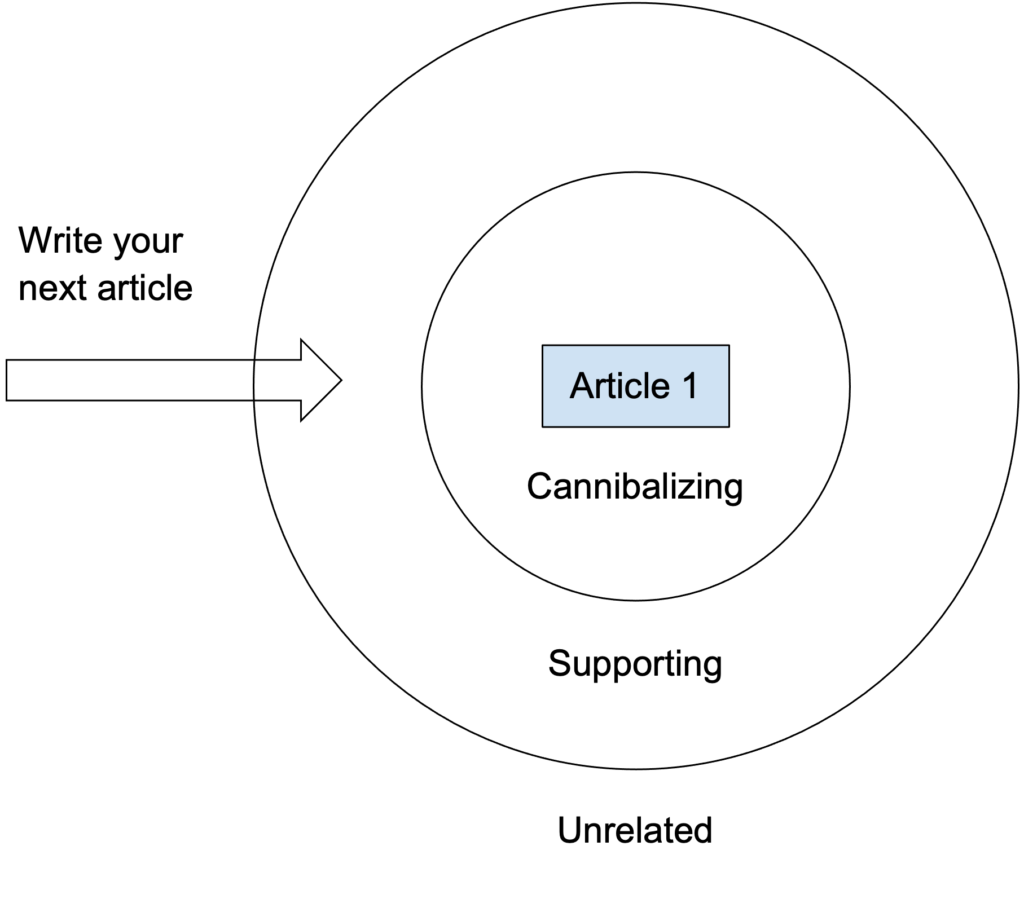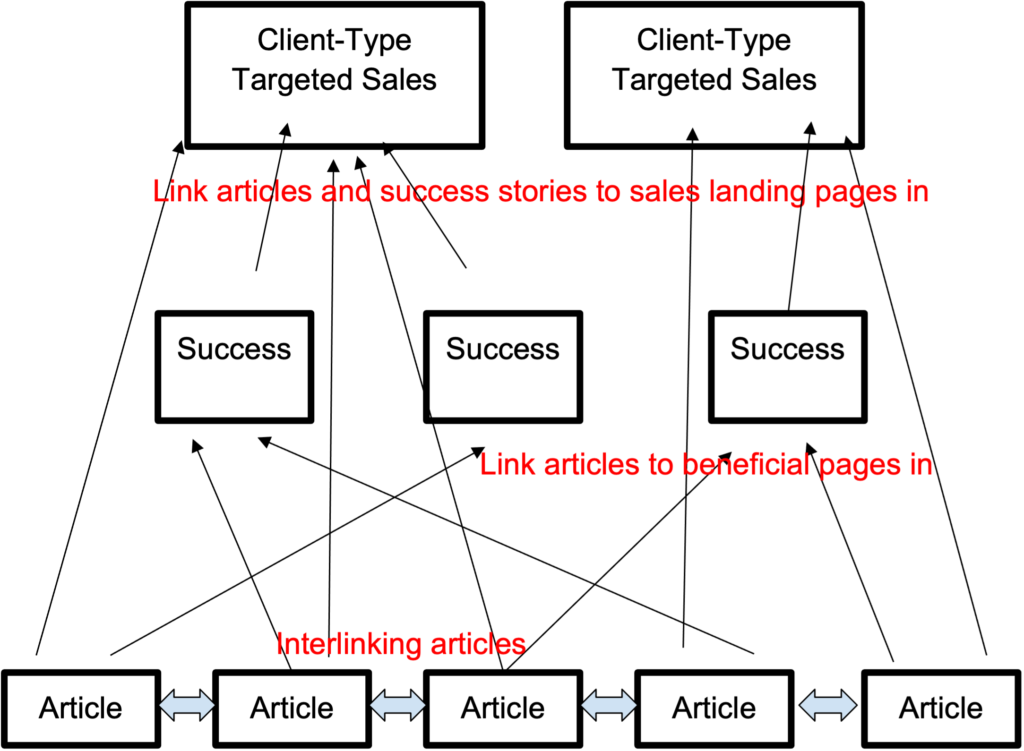Content is a great way to drive organic traffic to your site, but it isn’t as simple as picking a topic and writing an article. You need to understand how to develop a blog content strategy that reaches your goals in the most efficient way.
This entails finding the balance between several pairs of outcomes:
- Maximize topical authority, but minimize content cannibalization
- Drive the most visitors, but only those who are useful to your goals
- Improve lead quantity, but not at the expense of lead quality
Don’t worry if you don’t understand all of these terms yet as I’m going to explain them all. I’ll also provide you with a handful of handy charts so you can explain them to the rest of your marketing team too.
What is a content map?
A content map is the overall plan for your content. Content can come in many forms: video, audio, images, and text. Text content can be found on many different pages across your website: the blog, landing pages, and success stories.
In this article, I’ll focus on how to develop a blog content strategy, but one of the included charts shows how you integrate your blog content into the other content and copy on your website.
I recently posted an article providing three content map templates that will help you organize your website for maximum effect. I’m also currently working on a pair of documents for content planning and content tracking.
What is domain authority?
Moz calls it domain authority. Ahrefs refers to it as domain rating. SEMrush calls it Page Authority Score. Whatever website you use (and I personally recommend Ahrefs), they are all estimates of Google’s assessment of your page’s quality.
They are largely based on the quality of your backlinks.
What are backlinks?
Backlinks are essentially other websites linking to your website and thus conferring their clout onto your website. It cannot be stressed enough how important backlinks are, which is why I aim to get backlinks to my website in the “about the author” blurbs connected to the writing I sell to other websites. Another strategy for building backlinks is through PR using Help A B2B Writer.
Backlinks represent half of the SEO battle, while something I’ll refer to as “topical authority” here is the other half. I define topical authority as how much knowledge Google thinks you have on a specific topic.
You can build a great deal of topical authority by writing articles that are on similar and related topics and then interlinking between these articles. However, you need to be careful that the topics are different enough from each other to prevent content cannibalization.
What is interlinking?
Interlinking is linking between different pages on your websites. I visualize below in some of the charts exactly how to run your interlinking strategy. Here’s a summary:
- Link related articles in content clusters together.
- Link new articles to older articles.
- Go back to link old articles to new ones.
- Link your valuable content to success stories and landing pages.
What is content cannibalization?
Content cannibalization occurs when you write two or more articles that are too similar. Too similar here is defined as articles that compete for the same search intent.
Search intent is basically what a person wants to see when they type a word, phrase, or question into Google. If you have two articles that fulfill the same search intent, then they will compete in the Google search results and end up with fewer total clicks than either would individually.
Who do you want visiting your page?
Are more visitors always better? What about leads? The answer to these questions are no. To explain this, let’s start with a quick aside on vanity metrics.
Metrics are basically simple values (think a key performance indicator or KPI) that answer questions about how your business is doing. Vanity metrics are metrics that either have no true relevance to your company or can be improved independently of improving your business.
Your visitor count is probably the most famous vanity metric in marketing. That is, unless your business surrounds ad revenue, more visitors is not always better.
Visitors vs. leads
Instead of visitors, you should be tracking leads. Leads are basically visitors who have signaled in some way that they are actually interested in your product.
The typical measure of a lead over a visitor is the visitor giving you their email address. So, you should be focusing on leads over visitors. First, you need to concentrate your content production on topics that are specifically interesting to your visitors. Second, you need to focus your interlinking strategy on nudging visitors towards pages where they will provide an indication they are leads.
Lead quality vs. lead quantity
While getting a higher percentage of visitors to be leads is a great accomplishment, you might still find yourself in a situation where your lead quantity increases but your lead quality decreases.
Lead quantity is pretty self-explanatory. It is the number of leads. You can put this as a number (e.g., “11 leads last week”) or as a percentage of visitors (e.g., “0.5% of visitors are leads”).
Lead quality is how good your average lead is. We can think of this in two basic ways: the percentage of your leads that become wins or the average customer acquisition cost (CAC) of your lead pool.
Leads to wins
A win is a closed deal that ends with a customer signing on to your platform. You can measure lead quality by the percentage of your lead pool that ends up in wins. If you are getting more leads, but a lower percentage of them is ending up in wins, then you may have a lead quality issue.
If you have a long sales funnel that requires a lot of expensive live demos, then this can bleed you dry. This is a case where finding better indicators of interest might be the best solution.
For example, clients who give you their phone number are far better qualified as leads than those who only give you an email address. If you have a lead quality issue, consider shifting email-only leads to a nurture email campaign and those who give you their phone number to the stronger direct sales channel.
Customer acquisition cost
As mentioned above, customer acquisition cost (CAC) can be the difference between a profitable and growing enterprise and bankruptcy. If your sales funnel is particularly expensive, then you’ll need to take even more care to improve lead quality vs. lead quantity.
The sales team will dictate to the marketing team that they shouldn’t limit their lead count. However, being able to segment the lead pool into a high-quality group vs. low-quality group will help you focus on signing up the cheaper wins directly while shifting the lower quality leads to a cheaper, longer sales route.
Let’s now look at some charts that explain how to develop a blog content strategy.
Five charts that show you how to develop a blog content strategy
Here are the five charts I promised. Together they show you how to develop a blog content strategy that meets the goals of a B2B SaaS company.
Chart 1: Picking your next article
When choosing an article to write, you want to pick a topic that is related to the topics you have already written about but not too similar. A good way to make sure that an article isn’t too similar to the one you’ve already written is to search both topics on Google (or use Ahrefs, SEMrush, etc. to see the rankings) and see if different results come up.
If the top 5 results are all different, then that’s a good indication that the topics are not too related. If the top 50 results are all different, that might be an indication that the topics are not close enough. Take a look at this chart:

Chart 2: Balance content cannibalization and topical authority
Consider writing topic clusters with a pillar article and support articles to maximize your topical authority while avoiding content cannibalization. A pillar article is usually as long as all supports combined and aims at winning a harder keyword. The support articles are on related topics and interlink with the pillar to push its ranking up. I explain content clusters a bit more and provide some templates you can use to organize them here.
The pillar article should then rank higher than a single standalone article. However, if you fail to avoid content cannibalization, then all articles will rank worse than if you’d only written one article. Take a look at this chart:

Chart 3: Complete your topical authority and then move on
It’s important to fully explore a topic before moving on. For example, if you are going to write articles about financial statements, as I did for Baremetrics recently, then you’ll want to write about each statement, each component of the statements, etc. before looking at the next topic to explore.
Once you really own a topic, find a couple related topics and then start over. Repeat this process for every topic that you think your prospects are interested in until your website is a knowledge base that brings you leads organically. Take a look at this chart:

Chart 4: Link old articles to new ones, too
All else being equal, older articles attract more clicks than newer ones. They are more likely to have amassed a bunch of backlinks that drive visitors to your site, and Google sees this strength and shows those sites to more people using their search engine.
Be sure to use my free blog content planner template to keep track of all your articles. Storing all your links in one place will make interlinking old to new way easier!
Let’s say you can get 10% of people reading an article to click through to a second one. If your new article is getting 10 visitors a month, then that pushes a single visitor to your older page. However, iIf your old article is getting 1000 visitors a month, then that’s 100 visitors to your new page.
That’s a huge difference. Take a look at this chart:

Chart 5: Nudge users to more salesy content
It’s rare for someone to click on something as self-serving as a success story in Google. However, these pages that are a balance between valuable content and a sales landing page are a great bridge between them.
For that reason, I recommend that you add inbound links to your pages that go to three places:
- Other blog articles (standard interlinking)
- Success stories/case studies/testimonials (that appeal to interested prospects who want to get a bit more information about your product)
- Sales landing pages (that push visitors into your lead funnel)
Take a look at this chart:

Ask me how to develop a blog content strategy for you
There you have it. I was going to name this article something like “Five Charts to Explain Content Marketing to Your CMO” but I went with something less click-baity. However, I think it fits. I’ve definitely used these with CEOs, CMOs, and VPs of Marketing. They work. If you are interested in my content writing, content strategy, fractional CMO, or inbound marketing consulting services, reach out on LinkedIn. My inbox is always open to anyone!

